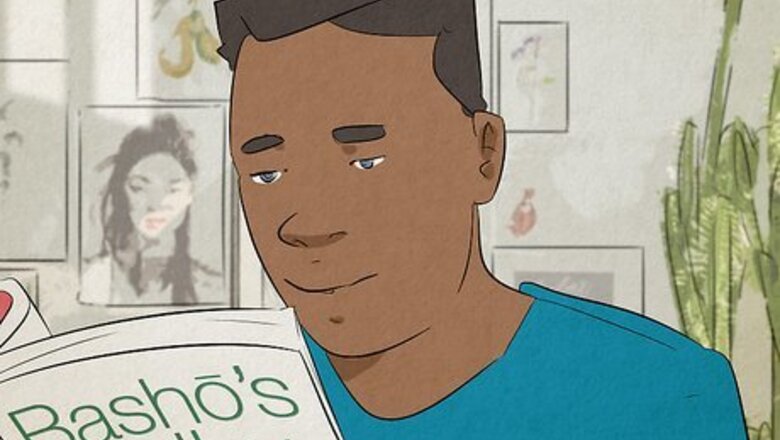
views
X
Research source
Read on to learn everything you need to know to write a powerful haiku poem of your own.
Brainstorming Ideas
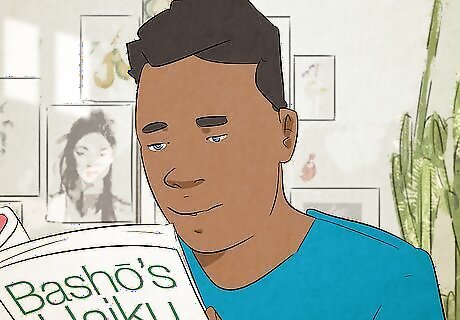
Read classic haiku to get a sense of the form and structure. You'll write better haiku if you're familiar with haiku that are well-known and considered good examples of the form. When you read, focus on the imagery and the moment captured by the poem. Let go of the nit-picky desire to count syllables—just lose yourself in the image conveyed. Here are some to get you started: Matsuo Basho Yosa Buson Kobayashi Issa Winner and Runners-up of the Society of Classical Poets 2021 Haiku Competition

Go for a walk in nature. Since most traditional haiku talk about nature, a walk in nature is a good way to brainstorm for ideas. Observe your surroundings silently, absorbing everything around you. If nature isn't available to you, look at photographs or videos of nature instead. For this to work, you need all of your senses present—don't take this walk while playing music through headphones. Take a notebook and a pen with you so you can write down your observations. You can also record your observations using the notes app on your smartphone. If you go that route, turn off notifications first so you don't have any distractions. Don't want to write about nature? That's technically a senryu, which follows the same basic structure, but is more about humanity than nature.

Meditate to orient yourself in the present moment. A haiku is a moment captured and conveyed in the present tense, as it's happening. Focus on your breath to bring yourself into the present moment, then quietly observe the world around you. Really immerse yourself in the moment, absorbing every detail you can. It can help to look at the big picture and then think of "zooming in" on a single thing and capturing every possible sensory detail associated with it. For example, you might be looking out at a forest and focus on a single leaf falling.
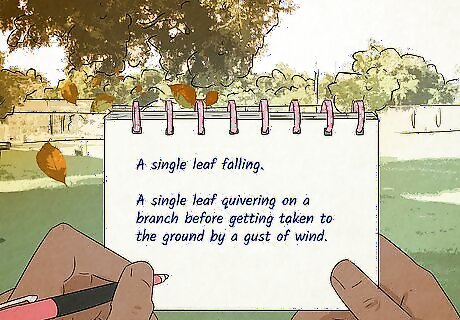
Jot down little moments you notice as you observe your surroundings. You want a lot of different things to choose from, so write down as many things as possible that you see. A haiku can come from even the tiniest observation. You won't use all of these, so don't worry if they don't seem to relate to each other at all. For example, if it's fall, you might notice that the leaves are falling from the trees around you. Go smaller! A single leaf falling. A single leaf quivering on a branch before getting taken to the ground by a gust of wind.
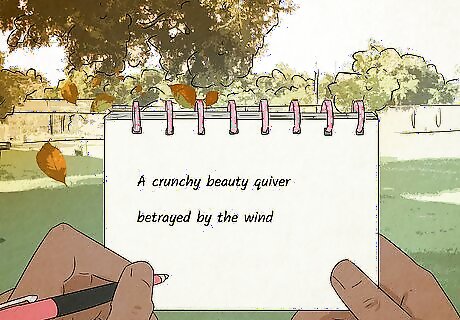
Describe each moment using sensory words. This can be a single phrase or a list of words. Try to include as many of the 5 senses as possible—it gives you more to work with when you start drafting your haiku. Stick to shorter words, which have more versatility in the haiku format. For example, if one of your moments is a single leaf falling, you might list words such as "brown," "crunchy," and "dry." Haiku poems aren't supposed to rhyme, so you don't have to worry about that as you're trying to think of words.
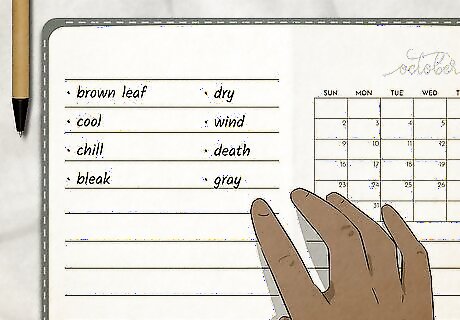
Make a list of seasonal words to put your moments in context. Seasonal words include names for months and the seasons themselves, as well as temperature words and weather words. Phrases that talk about the light, the atmosphere, or the length of the day can also reflect the season to your readers. For example, if it's currently fall, you might write down words such as "crisp," "cool," "harvest," and "dusk."
Drafting
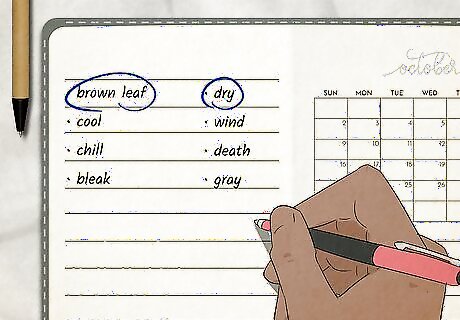
Choose 2 distinct images from your brainstorming lists. The essence of haiku is the juxtaposition of 2 distinct images to reveal a surprising or enlightening relationship between them. For your haiku, these 2 images can be literally anything on your list. The important thing is that they are distinct from each other. For example, you might choose a leaf falling to the ground and a gust of wind as your 2 images. The second line of a haiku typically includes a "cutting word"—this is a Japanese concept that doesn't really exist in English, but you can think of this as a moment that pivots, or changes, your scene.
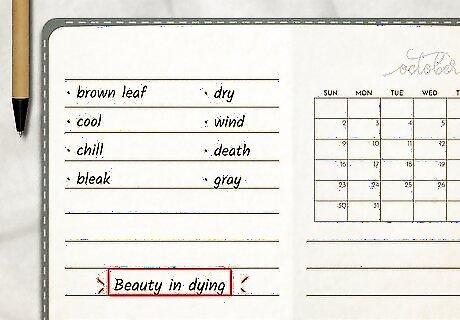
Come up with a surprise for the third line. The third line of a haiku relates the images conveyed in the first 2 lines to life or the world at large in an interesting and surprising way. Ideally, you'll come up with something that's thought-provoking and inspirational to your reader. For example, if your haiku is meditating on a single leaf falling to the ground, you might think about how beautiful the leaves are in the fall. They only get their colors because they're dying, though, and death is not something people normally consider beautiful. There's your surprise. You can also use wordplay to create your surprise. Throwing in a pun takes your poem beyond its literal meaning to surprise and amuse your readers. Nothing in a haiku has to rhyme, but an unexpected rhyme could also fit the bill for the third line.
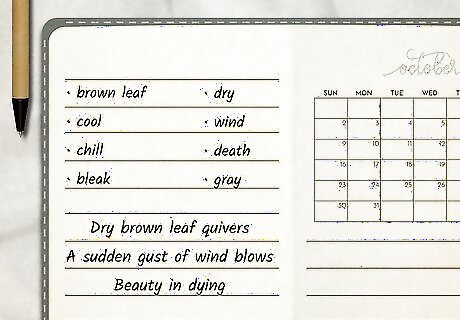
Fine-tune your lines to fit the 5-7-5 syllabic structure. A syllable is simply a unit of spoken language that consists of a single vowel sound. A traditional English haiku has 5 syllables in the first line, 7 syllables in the second line, and 5 syllables in the third line. Watch how this might work with the fall leaf haiku example: In the first line, the leaf is still clinging to a branch of the tree. You might write, "Dry brown leaf quivers." That's 5 syllables, so there's your first line. The second line features the moment of the gust of wind, which also serves as your "cutting word." You might write, "A sudden gust of wind blows." Your third line surprises your reader by equating death with beauty. You might simply write, "Beauty in dying."
Revising and Polishing
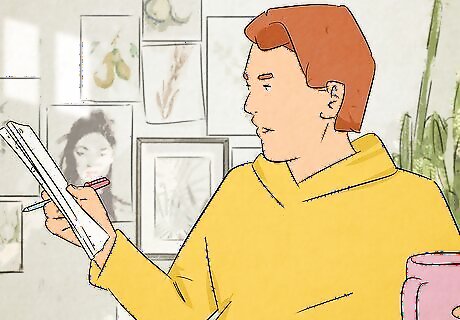
Read your haiku aloud. Wait at least a few hours (preferably a day) after you draft your haiku to go back to it. Read it aloud several times and feel the rhythm. Take note of any stumbling or awkward spots—you'll need to fix those. Even if your haiku reads smoothly, there still might be better words you can use. A haiku is short, so every word counts! Ask yourself the following questions: What is this word showing my readers? Is there another word that would do a better job of showing the same thing? Are there any words that tell readers what to think or feel, rather than showing them? How can you show them the moment more directly?
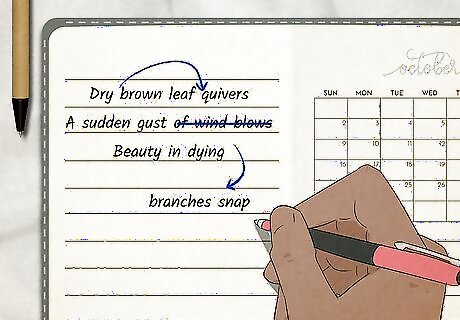
Revise your haiku based on your observations. Play around with words and images to improve your haiku and help it read more smoothly. You can see how this might go with the fall leaf haiku example: In the first line, the word "quivers" is really evocative, so you definitely want to keep that. "Dry" and "brown" aren't exactly inspired, though. Perhaps if you changed the order? "Brown leaf dry quivers" seems more interesting and poetic. The second line definitely has problems. "Gust of wind" is somewhat redundant, and "blows" seems totally unnecessary—what else does a gust of wind do, but blow? Try instead "A sudden gust; branches snap," which enables you to use the semi-colon as your "cutting word." The third line cleanly conveys your surprise, so you could leave it as it is.

Share your haiku with others. Get feedback on your haiku from your friends and family members. Ask them if they can see the moment in their heads or if they think your haiku embodies the season well. Other people often come up with things you wouldn't have thought of on your own. They can really inspire you and give you fresh insight into your poem. Feel free to revise your haiku even further based on the feedback you receive.
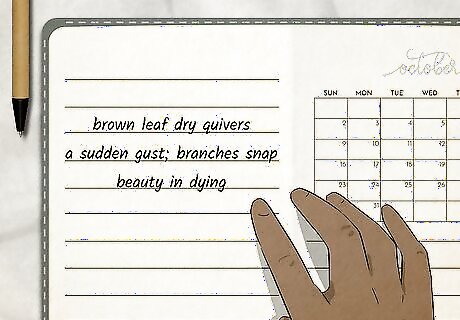
Format your haiku on the page. Traditionally, haiku are formatted with each line centered so that they form a diamond shape. Punctuation and capitalization are entirely up to you! The haiku form doesn't require anything specific, so you can use all lower-case letters with no punctuation at all if that's what you want. Haiku traditionally don't have a title. You might add a short one for clarification, but it's usually not necessary and will only detract from the impact of your poem. To follow through with the example, the final haiku would be:brown leaf dry quivers a sudden gust; branches snap beauty in dying















Comments
0 comment